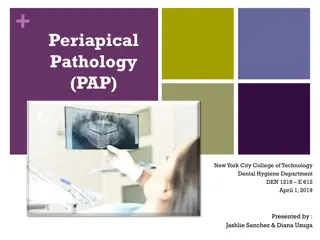Overview of Jaw Cysts: Classification and Clinical Features
A cyst in the jaw is a fluid-filled cavity lined by epithelium that commonly occurs in the jawbones. There are different types of jaw cysts, such as odontogenic cysts and non-odontogenic cysts, each with specific clinical features and radiographic appearances. Understanding the classification and fe
9 views • 13 slides
Veterinary Approaches to Lips and Cheeks Afflictions
Addressing various conditions affecting the lips and cheeks of animals, including open wounds, hare lip, retraction, dermatitis, tumors, cysts, and more. Treatments range from surgical interventions to topical applications for ulceration and retraction.
0 views • 10 slides
Understanding Nasmyth's Membrane and Dentigerous Cysts in Dental Health
Nasmyth's Membrane is a residue found on newly erupted teeth, causing extrinsic staining. It can be treated with selective polishing and proper brushing. Dentigerous cysts, odontogenic cysts associated with developing teeth, may lead to dental issues. Treatment for cysts includes monitoring and, if
0 views • 9 slides
Understanding Periapical Pathology in Dental Hygiene
Periapical pathology involves diseases around the tooth apex, such as abscesses, granulomas, cysts, and more. This presentation delves into identifying and differentiating these conditions, highlighting symptoms and radiographic features of each. Understanding these pathologies is crucial for dental
0 views • 12 slides
Understanding Odontogenic Cysts in Maxillofacial Region
Odontogenic cysts may occur centrally within bones of the maxilla and mandible, predominantly in tooth-bearing areas. Types include radicular cysts, residual cysts, and dentigerous cysts, each with distinct radiographic features and epicenter locations. Radicular cysts are commonly found around nonv
0 views • 7 slides
Overview of Giardia lamblia Parasite and Giardiasis Disease
Giardia lamblia, also known as Giardia intestinalis, is a flagellated parasitic microorganism that causes giardiasis by colonizing the small intestine. It infects humans, cats, dogs, and birds, and is a common parasitic human disease globally. Giardiasis, popularly known as beaver fever, can lead to
0 views • 12 slides
Understanding Echinococcus Granulosus and Hydatid Disease
Echinococcus Granulosus, also known as the hydatid worm or dog tapeworm, causes cystic echinococcosis. The tapeworm has distinct characteristics and a complex life cycle involving canids as definitive hosts and humans as accidental hosts. Hydatid disease in humans can be dangerous, with symptoms var
0 views • 8 slides
Understanding Entamoeba Histolytica: A Detailed Overview
Entamoeba Histolytica is a zoonotic protozoan parasite found in the digestive tract of various hosts. It mainly exists in two stages - Trophozoite and Cyst. Trophozoites are characterized by their size, clear ectoplasm, and movement via pseudopodia. Cysts are resistant structures with different cont
1 views • 30 slides
Understanding Choledochal Cysts: A Congenital Anomaly of the Biliary Tract
Choledochal cysts are congenital anomalies of the biliary tract characterized by cystic dilatation at various segments. They can lead to complications like biliary cirrhosis and recurrent pancreatitis. Clinical features include jaundice, abdominal pain, and right epigastric mass. Early detection is
0 views • 22 slides
Understanding Neck Swellings and Cysts
Explore the anatomy of neck muscles, main categories of neck swellings, and different types of cysts like ranula, dermoid cyst, and thyro-glossal cyst. Learn about their characteristics, locations, and treatment options. Visual aids included.
0 views • 74 slides
Comprehensive Overview of Jaw Imaging Modalities and Pathologies
Comprehensive overview detailing jaw imaging modalities such as X-Ray, CT, and MRI for evaluating jaw bone and tooth conditions. Covers anatomy, common mandibular lesions, odontogenic cysts, non-odontogenic cysts, and odontogenic benign tumors. Provides details on diagnostic protocols, imaging findi
0 views • 7 slides
Understanding Reproductive Disorder Diseases and Hormonal Infertility in Simple Language
Reproductive disorders can lead to infertility or sterility in animals, affecting their ability to reproduce. Causes include anatomical, functional, infectious, and management factors. Hormonal infertility may result from issues like cystic ovaries, delayed ovulation, or inactive ovaries. Conditions
0 views • 14 slides
General Characteristics of Coelenterata in Zoology Department at Benha University
Coelenterata is a subkingdom of Metazoa with aquatic, symmetrical body structures found in marine or freshwater environments. It exhibits alternation of generations between polyp and medusa forms. Tentacles aid in food capture and defense, while unique stinging cysts called nematocysts are present.
0 views • 20 slides
Pancreatic Disorders and Management Options Overview
Tropical Pancreatitis, genetic mutations, and pancreatic cyst management are discussed in the content alongside a clinical case of a 65-year-old man with a pancreatic mass. Topics include Tropical Pancreatitis features, differential diagnosis of pancreatic masses, and management options for chronic
0 views • 63 slides
Understanding Wrist and Hand Disorders: Common Conditions and Symptoms
Wrist and hand disorders encompass a range of conditions such as carpal tunnel syndrome, De Quervain syndrome, ganglion cysts, Kienbock's disease, arthritis, and hand infections. Common symptoms include pain, numbness, swelling, and difficulty gripping. Learn about the causes and treatments for thes
0 views • 13 slides
Overview of Common Surgical Liver Diseases and Portal Hypertension
The liver plays a crucial role in metabolism, coagulation, and immune function. Surgical diseases of the liver, such as liver cysts and cavernous haemangiomas, can impact its normal functions. Imaging modalities like ultrasound (US), CT scans, and MRI are essential for diagnosing and staging liver t
0 views • 46 slides
Comprehensive Overview of Salivary Gland Diseases and Management
Salivary gland diseases encompass various conditions affecting the salivary glands, including developmental abnormalities, inflammatory and non-inflammatory enlargement, cysts, tumors, and dysfunction. Investigations such as plain films, sialography, MRI, and biopsies are essential for diagnosis. Si
0 views • 49 slides
Understanding Parasitic and Non-Parasitic Materials in Feces Examination
When examining feces for parasites, it's crucial to differentiate between parasitic material, non-parasitic material, and pseudoparasites. Recognizing parasite eggs and cysts based on their shape and size is essential for accurate identification. Additionally, being aware of non-parasitic materials
0 views • 7 slides
Reproductive System Diseases and Conditions Overview
This comprehensive overview covers various diseases and conditions of the reproductive system, ranging from sexually transmitted infections like syphilis and gonorrhea to reproductive issues like ovarian cysts and infertility. It also discusses conditions such as pre-eclampsia and menopause. The inf
0 views • 7 slides
Understanding Kidney Disease and Health in India
Chronic kidney disease (CKD) is prevalent in India, with one in every 10 adults affected. The kidneys play vital roles in regulating the body, such as filtering waste and balancing fluids. Diabetes, high blood pressure, and family history are common risk factors for kidney disease. Recognizing sympt
0 views • 13 slides



















